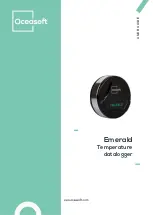
I2773-4.
4
en
63
Somat eDAQ
lite
Notes on Using Setup Files from Previous TCE Versions
Consider the following when using setup files from previous versions of TCE.
•
Serial bus channels defined in TCE setup files prior to V3.8.2 are invalid. Delete these channels from the setup file and
add them from the new serial bus databases provided with later releases.
•
TCE automatically updates J1708 channels created using the original J1587 version of the database. Note that TCE
removes all vehicle speed, latitude, longitude and altitude channels if they exist in the TCE setup file.
Importing a Network Node
The network setup window provides an option to import previously defined network
node from a saved TCE setup file into the existing setup. Select Import in the network
setup window to begin the import process. Importing a network node extracts all the
information associated with the node including hardware, transducer and computed
channels and DataModes.
TCE does not import any channels or DataModes with ID names identical to existing
channels or DataModes in the defined test. If this situation occurs, delete the newly
imported node, rename the duplicate IDs in the existing setup or in the setup
containing the network node and import the node again.
Extracting a Setup from a Data File
To extract a TCE setup file from a SIE or SIF data file, select Open SIE or SIF File from
the File menu. After choosing the desired data file, select Keyword Extraction Options
and then TCE Setup File to PC File. Save the file and open it in TCE as any other
previously saved setup file.
4.2
Calibrating Input Channels
Transducer calibration for the eDAQ
lite
system is independent of a specific signal
conditioner or hardware layer. The transducer calibration definition is solely in terms of
the relationship between the transducer output signal (i.e., voltage for most transducer
types) and the selected engineering units. Note that this relationship is dependent on
the excitation settings, the use of an excitation signal and the bridge settings for
applicable types of transducer channels.
For a transducer that has not been calibrated, indicated by a “No” as its calibration
date, select Cal in the transducer channel setup window to begin calibration. For
calibrated transducers, select Cal to perform one of several calibration control options.
NOTE
For some channel types, TCE completes the calibration date parameter when the
channel is created. To calibrate these channels, first delete the calibration by selecting
Cal and choosing the Delete Calibration option.
4.2.1
Calibration Modes
Modify the calibration mode on the second page of the channel definition window,
accessible with the Edit option or by double clicking the channel. The two mode
parameters define the two steps required to uniquely determine the calibration line
HBM: public
Summary of Contents for eDAQlite
Page 1: ...User Manual English Deutsch Espanol I2773 4 4 en HBM public Somat eDAQlite with TCE Software ...
Page 2: ...Somat eDAQlite 2 I2773 4 4 en HBM public ...
Page 16: ...Somat eDAQlite 16 I2773 4 4 en HBM public ...
Page 22: ...Somat eDAQlite 22 I2773 4 4 en HBM public ...
Page 88: ...Somat eDAQlite 88 I2773 4 4 en HBM public ...
Page 106: ...Somat eDAQlite 106 I2773 4 4 en HBM public ...
Page 128: ...Somat eDAQlite 128 I2773 4 4 en HBM public ...
Page 190: ...Somat eDAQlite 190 I2773 4 4 en HBM public ...
Page 202: ...Somat eDAQlite 202 I2773 4 4 en HBM public ...
Page 222: ...Somat eDAQlite 222 I2773 4 4 en HBM public ...
Page 224: ...Somat eDAQlite 224 I2773 4 4 en HBM public ...
















































